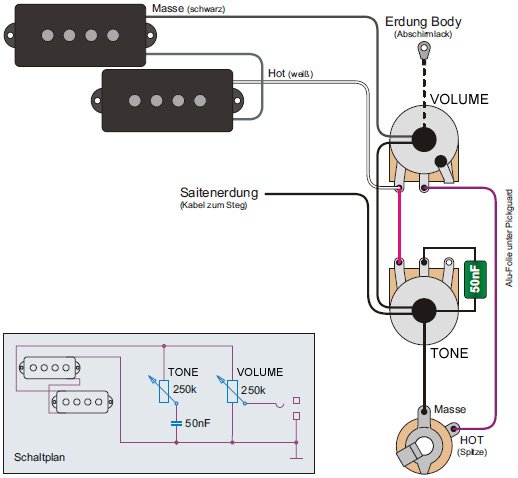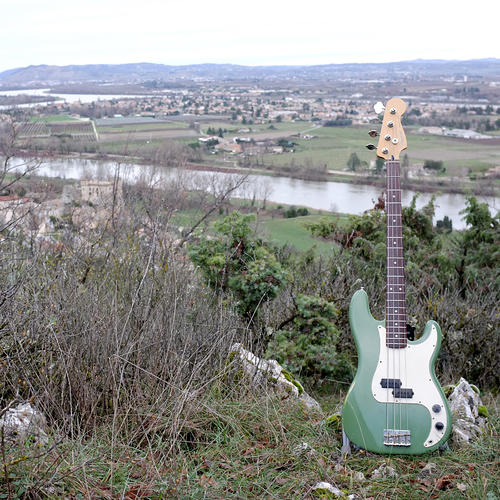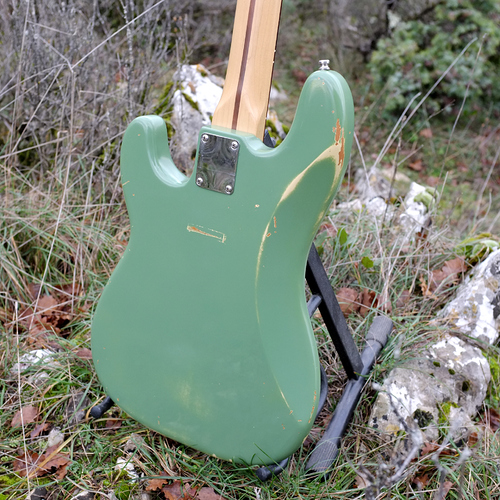with very thin (000) steel wool. I do this on every instrument with rosewood fingerboard, each time I remove the strings. it’s really easy and fast, no more than a few minutes for the whole neck.
What oil do you use?
What bridge did you remove @terb?
I use simple linseed oil, I let it set about 2 hours and then I remove the excess
the Fender Hi-Mass Brass, and I will explain why on the dedicated topic ! ![]()
by the way, now Greenie is fully re-assembled ; I will shoot some pictures when the sun will be back here ![]() and I will also explain my electronic mods (pot and capacitor value choice)
and I will also explain my electronic mods (pot and capacitor value choice)
So, I changed the two pots on Greenie. The original pots were perfecly working but I wanted to tweak a little bit.
First of all, here is a standard Precision Bass wiring (in german but we don’t care) :

Not much to say, it’s a very simple circuitry with a voltage divider as volume control, and a RC (Resistor + Capacitor) low-pass filter as a tone control ; the resistors being in fact the potentiometers.
The stock pots are both 250k log. Not that, depending on your location, the pot values will be different. It’s strange but in fact it’s just a matter of tolerance, the real values are the same. So an european pot of the same value will be sold as a 220k pot. Same thing for a 500k US pot = 470k european pot , same thing with a 50nF capacitor = 47nF european capacitor. Yeah, I know, it’s a pure unneeded confusion.
So, on Greenie the only stock electronic part is … the jack plug  The pickup is a DiMarzio with a much higher output level than a standard Fender pickup. It gives a fatter, bigger tone. And with such a pickup, the 250k volume pot is in my opinion a little bit too low. This pot works as a load for the pickup. The lower the pot value is, the darker the tone will be. The load will “eat” the signal detail which is the treble content of the audio spectrum = you will loose some clarity and the overall sound will be darker. It’s not “bad” or “good”, it’s just a physical thing that happen on the audio spectrum. A high-output pickup like my DiMarzio is darker than a stock pickup, and is also more sensitive to a lower load (= low volume pot value). I wanted to bring back some grit, some agressivity in the high end of the spectrum. That’s why I put a 500k volume pot.
The pickup is a DiMarzio with a much higher output level than a standard Fender pickup. It gives a fatter, bigger tone. And with such a pickup, the 250k volume pot is in my opinion a little bit too low. This pot works as a load for the pickup. The lower the pot value is, the darker the tone will be. The load will “eat” the signal detail which is the treble content of the audio spectrum = you will loose some clarity and the overall sound will be darker. It’s not “bad” or “good”, it’s just a physical thing that happen on the audio spectrum. A high-output pickup like my DiMarzio is darker than a stock pickup, and is also more sensitive to a lower load (= low volume pot value). I wanted to bring back some grit, some agressivity in the high end of the spectrum. That’s why I put a 500k volume pot.
Note that it won’t make a huge difference. It’s kind of like new strings compared to a bit older strings. The overall tone won’t be really different : a P will still sound like a P with a 250 or 500k pot. But the attack will be different.
I chose a linear pot and not a log pot. It’s the curve of the resistors modulation when you turn the pot. I’ve always prefered linear pots for volume controls. It’s very hard to explain and I think you have to experience this to make your own opinion, as it all depends on the sound and behavior you like. I’d say that, the more overdrive you use, the more logical it is to use a linear volume pot. But a log volume pot can work pretty good too. It’s different for a tone pot, where I recommend only log pots.
I also changed the tone pot and capacitor on Greenie, but with the same values than on the original circuitry (to be short, let’s say the reason I changed those parts is not the tone).
The capacitor value sets the frequency of the low-pass filter of the tone control. The higher the value, the lower the cut frequency. It’s hard to give a perfect value, because the RC filter will interact with the particular pickup mounted on the intrument, and difference frequencies will give different behaviors when turning the tone pot. There is a matter of taste here, and some value can suit more a particular musical style ; for example, if you play Motown/Jamerson things, a lower value like 100nF will help having a very dark/deep sound even with round-wound strings.
Also you need to know that the tolerance is very high (like 20% !) on capacitors, because of the manufacturing process. So, if you take two capacitors with an identical theorical value, they will probably have a significantly different real value, so the frequency of the filter will be different and the tone filter will behave and sound differently. It means that if you’re searching for the perfect tone control on your bass, you’ll have to experiment with different capacitors, for each value.
The type of the capacitor is not important at all, because the current and voltage are extremely low on a passive bass circuitry. If you read that a Orange Drop capacitor sounds better, it’s pretty simple : it’s false. A lot of testing has been made to be sure (including by me) and, yes, this is sure : the capacitor type (and price !) is totally irrelevant in this particular use. I use standard polyester 63v capacitors.
'hope there are some interesting informations here 

Wow… you sure you are not a professional mod’er/luthier?? 
I’ve designed / built / modded dozens of amps and hundreds of pedals, so a Precision Bass is not too complicated  and I tried to keep the things not-too-unreadeable
and I tried to keep the things not-too-unreadeable 
By the way, one day I’ll have to sample the two pedals I’ve designed for a french brand called Custom 77 (one clean/treble booster and one overdrive)  One day I could also sample some amps I’ve built, some of them work pretty good with a bass
One day I could also sample some amps I’ve built, some of them work pretty good with a bass 
if you’re interested here is a review/test video about the overdrive pedal I designed for Custom 77 (designed from scratch) :
Also I could precise that what I said about the electronics on Greenie is more like taking Greenie as an example (who needs to know the exact schematic of my main bass ?  ). everything I said works with any passive bass. of course sometimes there are some others things to think about, like multiple pickups blending, but the general basics are the same.
). everything I said works with any passive bass. of course sometimes there are some others things to think about, like multiple pickups blending, but the general basics are the same.
@terb I tried searching for Custom 77 guitar pedals and couldn’t find a website.
Disclaimer: I have zero real world experience, just what I’ve read and researched on the Internet.
My understanding about linear and logarithmic pots is that log pots are usually used for volume control since we hear in logarithmic increases. Why do you prefer linear pots for volume?
yeah very sadly those pedals have been discontinued recently ![]()
that’s a very good question indeed. and that’s what I said with (very) different words. in pure clean tone, the natural perception fits a log scale, you’re right. but when you play with overdrive, a linear scale is much more manageable. that’s why I said I recommend linear volume pots when you use mainly overdriven tones ![]()
Oh well. Still, it’s pretty damn cool to be able to point at something and go, “You see that? I built that.”
Ah, thanks. Yes you did. Still new to this side of it all. I was trying to keep track of it in my head and that piece fell out when I was going back over it. ![]()
yeah again at this point you all have to test things and decide what work best for you ! I just give my old recipes 
Wow @terb, sounds great and I love the idea of an optional buffer. Usually pedals are buffered or not.
that’s exactly why I designed this “parametric buffer” 
Is tht the stock neck? I didn’t know that some P-basses had a multipiece neck. Nice.
Yes it’s the stock neck, it’s not really a multipiece neck but just an insert to keep the truss rod in place from behind. A lot of Fender are made this way ! here is a quick picture of all my Fender guitars and bass to show you this neck construction :
Oh interesting!
Hey, @terb . . . the neck on my Squier J-bass has that strip, too.
Like @howard, I also thought it was a three piece neck, so thanks for clearing that up for us. 
Your Greenie project came out really nice! 
Cheers, Joe
that’s funny because I have a Squier Telecaster and this one does not have the darker wood strip on the back of the neck. but most Fender have and some Squier too (the higher end Squier I think).


